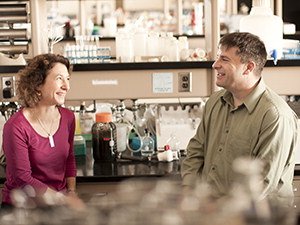Does antibacterial soap threaten wastewater treatment?

Paige Novak, professor of civil engineering, specializes in research on the biological transformation of hazardous substances, and has more recently been studying the ways that human-introduced contaminants disrupt microbial communities.
Novak has been collaborating with Timothy LaPara, professor of civil engineering and fellow BTI member, on how chemical spills, toxins, and other disruptions affect anaerobic microbial communities. These communities are critical in certain wastewater treatment facilities.
“If we understand the effect of these perturbations on anaerobic communities, we can recover them faster if there’s a problem,” explains Novak.
“You learn more by working with other people. I don’t do work on antibiotic resistance—that is Tim’s specialty. Collaboration let us see the picture of these two responses to triclosan—failure in function versus the acquisition of antibiotic resistant genes.”--Paige Novak
All wastewater treatment produces a solid material called sludge, made up of solids from the wastewater itself and the bacteria that are used to treat the wastewater. This sludge can be further treated through digestion by various bacterial communities, leaving behind a useful product called biosolids, while generating methane gas. Some treatment facilities capture this methane and use it to generate heat for the treatment system. These methane-generating microbes are essential to sludge treatment, and their output of methane is one indicator that they are doing their job.
Common personal use products that find their way into wastewater can disrupt critical microbial communities. For example, more than 100 metric tons of triclosan, widely used in antibacterial soaps, are flushed into wastewater plants annually. “The use of triclosan keeps increasing,” said Novak. “Besides soap, we are putting it in toys and clothes. Triclosan tends to stick to solids. It also doesn’t degrade readily under anaerobic conditions. Because it doesn’t degrade, it can accumulate in wastewater digesters.”
The EPA has found a range of concentrations of triclosan in wastewater treatment facilities. So Novak and LaPara examined the impact of triclosan within that range and at four times the maximum found concentration—an amount that might occur in a spill or in a region where the product is more widely used. “At four times the current maximum, we found that you get a significant drop in the function of these microbial communities. The microbes are not digesting at the rate we want and are producing less methane,” she said. “High concentrations of triclosan are bad for anaerobic digesters.”
Moreover, Novak and LaPara found that even normal concentrations of triclosan—those discovered by the EPA—result in a huge variation in methane production. “Some microbial communities do very poorly, and some do fine. We are not sure why yet, but we think this may indicate that at the high end of normal concentrations, the digesters are at a tipping point. Some digester communities begin to fail at the higher end of currently observed levels. There may be digesters in wastewater treatment facilities out there that are beginning to fail, that are becoming more variable in their operations, and that are more problematic because of these concentrations,” she said. Novak emphasizes more work is needed to translate these lab findings into what is happening in actual wastewater treatment plants.
In another finding, Novak and LaPara were curious about how anaerobic microbes that were previously unexposed to triclosan would react when triclosan was introduced. “We took material from an organic farm that had never been exposed to triclosan. Upon first exposure, there would be a blip in the methane production and then the organisms would adapt to behave like the microbial communities that have already been exposed to triclosan,” Novak said.
Moreover, they found that these communities developed antibacterial resistance. “Part of their adaptation was the development of antibacterial resistance. We need to look at more microbial communities to understand the results. It may be that some communities become resistant and others collapse,” Novak said.
“You learn more by working with other people. I don’t do work on antibiotic resistance—that is Tim’s specialty. Collaboration let us see the picture of these two responses to triclosan—failure in function versus the acquisition of antibiotic resistant genes,” Novak said.
